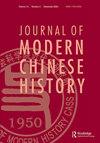Rethinking media history in modern China: the cases of lithography, slide shows, the telegraph, and motion pictures
IF 0.1
4区 历史学
Q4 HISTORY
引用次数: 0
Abstract
Marshall McLuhan (1911–1980), whommany consider the founding father of media studies, first coined the phrase “the medium is the message” in his Understanding Media: The Extensions of Man, published in 1964. Since then, this idea has been hammered into the heads of every first-year undergraduate student majoring in media studies. In Understanding Media, McLuhan states that “It is the medium that shapes and controls the scale and form of human association and action. The content or uses of such media are as diverse as they are ineffectual in shaping the form of human association.” In other words, the particular materiality of a medium not only constructs and creates a particular kind of message, but also affects how the message is received, understood, interpreted, and responded to. It can even be argued that every medium invokes human behaviors and thought patterns unique to that medium. Therefore, as far as communication studies and media history are concerned, a medium itself, not the content it carries, should be the focus of study. Although McLuhan’s proposition “the medium is the message” is widely accepted in communication studies, scholars in the field of media history still do not seem to have taken this idea seriously enough, as evidenced by their general preoccupation with content rather than the medium itself. For instance, some read through old newspapers to collect information relevant to a particular topic; others go through pictorial magazines in search of visual evidence as proof of particular facts. In both cases, the materiality of the medium itself, be it a newspaper or a pictorial magazine, is usually ignored. This problem is exacerbated by the wide use of digital technologies in research and further compounded by the need for libraries to protect the original materials in their collections bymaking them available only in digital format or reprints. Given the ease of using a computer to search for a particular word and the limited accessibility of original materials, researchers today often lack the opportunity to touch the actual medium itself. Consequently, there are many questions they cannot answer. What is the texture of the paper on which the words are printed?What is the exact original size of a slide or photograph?Was the movie in question shot on 16mm or 35mm film, with or without a sound track? And what about the print quality of a book, a pamphlet, or a newspaper? It is regrettable that most libraries in China do not collect audiovisual materials and that the few that do rarely make their collections available to the public. This too deprives scholars of a direct and unabridged experience with these media. Strictly speaking, any research on media history that fails to adequately consider the dimension of themedium itself does not qualify as media history. At best, such重新思考近代中国的媒体史:以平版印刷、幻灯片、电报和电影为例
马歇尔·麦克卢汉(1911-1980)被许多人视为媒体研究之父,他在1964年出版的《理解媒体:人的延伸》一书中首次提出了“媒介即信息”这一说法。从那时起,这个想法就被灌输到每一个主修媒体研究的大一本科生的脑海里。麦克卢汉在《理解媒介》一书中指出:“媒介塑造并控制着人类交往和行动的规模和形式。这些媒体的内容或用途是多种多样的,因为它们在塑造人类交往的形式方面是无效的。”换句话说,媒介的特定物质性不仅构建和创造了特定类型的信息,而且还影响了信息的接收、理解、解释和回应方式。甚至可以说,每一种媒介都能激发出该媒介特有的人类行为和思维模式。因此,就传播学和媒介史而言,研究的重点应该是媒介本身,而不是媒介所承载的内容。尽管麦克卢汉的“媒介即信息”这一命题在传播学研究中被广泛接受,但媒体史领域的学者似乎仍然没有足够重视这一观点,这从他们普遍关注内容而不是媒介本身就可以看出。例如,一些人通过阅读旧报纸来收集与特定主题相关的信息;另一些人则翻阅图片杂志,寻找视觉证据,作为特定事实的证据。在这两种情况下,媒体本身的物质性,无论是报纸还是画报杂志,通常都被忽视了。数字技术在研究中的广泛使用加剧了这一问题,而图书馆需要通过只提供数字格式或重印版来保护其馆藏中的原始资料,这进一步加剧了这一问题。考虑到使用计算机搜索特定单词的便利性以及原始材料的有限可及性,今天的研究人员往往缺乏接触实际媒介本身的机会。因此,有许多问题他们无法回答。印字的纸是什么质地的?幻灯片或照片的原始尺寸是多少?这部电影是用16毫米还是35毫米胶片拍摄的,有还是没有音轨?那么书籍、小册子或报纸的印刷质量如何呢?令人遗憾的是,中国的大多数图书馆不收藏视听资料,而少数有收藏的图书馆也很少向公众开放。这也剥夺了学者们直接和完整地接触这些媒体的机会。严格地说,任何对媒体史的研究,如果没有充分考虑到媒体本身的维度,就没有资格成为媒体史。充其量,就是这样
本文章由计算机程序翻译,如有差异,请以英文原文为准。
求助全文
约1分钟内获得全文
求助全文

 求助内容:
求助内容: 应助结果提醒方式:
应助结果提醒方式:


